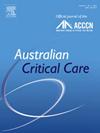Improving energy and protein intake via an oral nutrition support pathway in the intensive care unit and beyond: An uncontrolled before and after study
IF 2.7
3区 医学
Q2 CRITICAL CARE MEDICINE
引用次数: 0
Abstract
Background
Survivors of critical illness face multiple barriers to adequate oral intake. Research suggests these patients are not meeting nutrition requirements, yet no guidelines or published studies exist to improve energy and protein intake post critical illness.
Objectives
The aim of our study was to increase energy and protein intake of patients in the intensive care unit (ICU) and beyond onto the post-ICU ward via the implementation of a multidisciplinary, individualised oral nutrition support pathway.
Methods
We conducted a prospective single-centre, uncontrolled before-and-after study in a 10-bed ICU comprising 112 patients. Consecutively admitted patients expected to remain in the ICU for ≥48 h were followed up from commencement of oral intake for 15 days. Pre-implementation, patients received standard care, while post-implementation, patients followed the oral nutrition support pathway. This included energy- and protein-dense foods, oral nutrition supplements, and nutrition screening. Adequacy of energy and protein intake was expressed as the percentage of estimated energy requirements (EERs) and percentage of estimated protein requirements (EPRs) met, and the proportion of patients meeting ≥80% of their EERs and EPRs on average were compared pre-implementation and post-implementation.
Results
Post-implementation, there was a significant increase in the percentage of EERs and EPRs met with a mean difference between periods of 34% (95% confidence interval: 22–46) for energy and 28% (95% confidence interval: 16–40) for protein. The proportion of patients meeting ≥80% of EERs significantly increased post-implementation (pre: 19.6% vs post: 58.9%, p < 0.001) as did those meeting ≥80% of EPRs (pre: 12.5% vs post: 46.4%, p < 0.001).
Conclusions
A multidisciplinary, individualised oral nutrition support pathway significantly improved energy and protein delivery of critically ill and post–critically ill patients for 15 days from the initiation of oral intake. Further work is required to ascertain the impact of this on clinical outcomes.
通过口服营养支持途径改善重症监护病房及其他病房的能量和蛋白质摄入:一项不受控制的研究前后
危重疾病的幸存者在获得足够的口服摄入方面面临多重障碍。研究表明,这些患者没有达到营养要求,但目前还没有指导方针或已发表的研究来改善危重疾病后的能量和蛋白质摄入。本研究的目的是通过实施多学科、个性化的口服营养支持途径,增加重症监护病房(ICU)及ICU后病房患者的能量和蛋白质摄入量。方法我们在一个10张床位的ICU进行了一项前瞻性、单中心、非对照的前后对照研究,包括112例患者。预计在ICU连续住院≥48 h的患者自口服开始服药后随访15天。实施前,患者接受标准治疗,实施后,患者采用口服营养支持途径。这包括能量和蛋白质密集的食物,口服营养补充剂和营养筛查。能量和蛋白质摄入的充分性表示为估计能量需要量(EERs)的百分比和估计蛋白质需要量(epr)的百分比得到满足,并比较实施前和实施后平均满足EERs和epr≥80%的患者比例。结果实施后,EERs和epr符合的百分比显著增加,能量的平均差异为34%(95%可信区间:22-46),蛋白质的平均差异为28%(95%可信区间:16-40)。达到≥80% EERs的患者比例在实施后显著增加(实施前:19.6% vs实施后:58.9%,p <;0.001),达到≥80% epr的患者(治疗前:12.5% vs治疗后:46.4%,p <;0.001)。结论多学科、个性化的口服营养支持途径可显著改善危重症和危重症后患者口服15 d的能量和蛋白质输送。需要进一步的工作来确定这对临床结果的影响。
本文章由计算机程序翻译,如有差异,请以英文原文为准。
求助全文
约1分钟内获得全文
求助全文
来源期刊

Australian Critical Care
NURSING-NURSING
CiteScore
4.90
自引率
9.10%
发文量
148
审稿时长
>12 weeks
期刊介绍:
Australian Critical Care is the official journal of the Australian College of Critical Care Nurses (ACCCN). It is a bi-monthly peer-reviewed journal, providing clinically relevant research, reviews and articles of interest to the critical care community. Australian Critical Care publishes peer-reviewed scholarly papers that report research findings, research-based reviews, discussion papers and commentaries which are of interest to an international readership of critical care practitioners, educators, administrators and researchers. Interprofessional articles are welcomed.
 求助内容:
求助内容: 应助结果提醒方式:
应助结果提醒方式:


